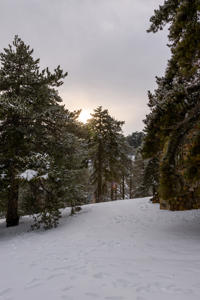Persephoni
Located atop the Troodos NFP, the Persephone Nature Trail offers hikers a unique opportunity to explore the most important natural area of Cyprus. The trail covers an area of 9.3 km2, making it a significant hotspot for biodiversity conservation according to the International Union for Conservation of Nature (IUCN). The Troodos mountain range, which is home to the trail, is the highest on the island, with its highest peak reaching an elevation of 1952 m at Chionistra or Olympus, while its lowest point is located at an altitude of 700 m.
Most of the Troodos NFP area is covered by dense natural forests, with calabrian pine (Pinus brutia) and golden oak (Quercus alnifolia) dominating up to an altitude of 1400 m. At higher altitudes, the black pine (Pinus nigra) and Troodos juniper (Juniperus foeditissima) take over. The Troodos NFP boasts an impressive collection of over 750 plant species, with 72 of them being endemic to Cyprus, including 12 that are considered local endemics. The area is also home to 11 habitats listed in Annex I of the European Habitats Directive and 10 Annex II-listed species.
In addition to its plant and animal diversity, the Troodos NFP is also geologically unique. The 90-million-year-old ophiolitic complex of the Troodos mountain range was once part of the seabed of the ancient Tethys Sea, which uplifted 15 million years ago due to the collision of the African and Eurasian tectonic plates that created the island. The combination of unique geology, climate, and landscape make the Troodos NFP an attractive destination for nature lovers, hikers, skiers, birdwatchers, botanists, and geologists alike.
The circular Persephone Nature Trail begins on a forest trail and then continues along a forest road for the return journey. At an altitude of 1660 m, the trail leads to the “Makria Kontarka” locality, where hikers can take a path to an impressive viewpoint. From here, visitors can enjoy panoramic views of the villages and vineyards of Lemesos district, the Cape Gata, and the Akrotiri Salt Lake. Cedar and juniper reforestations can be seen around the viewpoint. As hikers continue towards the end of the trail, they will be able to see the Amiantos Asbestos Mine and pass through a dense black pine forest. Along the trail, hikers will find signs with information about the various plants, shrubs, and trees that can be found in the Troodos Forest, many of which are endemic to the area, such as Troodos germander (Teucrium cyprium), Cyprus skullcap (Scutellaria cypria subsp. cypria), pterocephalus (Pterocephalus multiflorus subsp. multiflorus), Troodos sage (Salvia willeana), and golden oak (Quercus alnifolia).
Hikers on the Persephone Nature Trail will also have the opportunity to observe several endemic species of wild birds, including the Cyprus wheater (Oenanthe cypriaca), coal tit (Parus ater cypriotes), crossbill (Loxia curvirostra guillemardi), jay (Garullus glandarious glanzerii), and tree creeper (Certhia brachydactyla dorotheae), among others. The trail got its name from the goddess of Greek mythology Persephone, daughter of Zeus and Demeter. Hades, fascinated by her beauty, kidnapped Persephone while picking flowers, transferring her to the underworld. According to the myth, after her abduction, Persephone was rising from the underworld to Earth and returning back for four months, with her rise symbolizing the euphoria of nature and her descent the winter frost.
The Persephone Trail is not only home to a rich diversity of flora and fauna but also offers the opportunity to observe endemic species of wild birds, including the Cyprus wheater (Oenanthe cypriaca), coal tit (Parus ater cypriotes), crossbill (Loxia curvirostra guillemardi), jay (Garullus glandarious glanzerii), and tree creeper (Certhia brachydactyla dorotheae), as well as several other more common species.
In conclusion, the Persephone Trail in Cyprus offers hikers an opportunity to explore the natural beauty and rich biodiversity of the Troodos NFP. The trail offers breathtaking views of the area, rich vegetation, a dense black pine forest, and points of geological interest. Hikers can also observe many endemic species of wild birds, making it a must-visit destination for nature lovers, hikers, birdwatchers, botanists, and geologists alike.
Trail Information
Distance
3.0 km
Difficulty
Easy
Trail Type
Linear
Duration
02:00h
Min Elevation
1638 m
Max Elevation
1734 m
General Information
Ratings
Spectacular
3
Fantastic
4
Enjoyable
0
Average
0
Terrible
0
4.4


